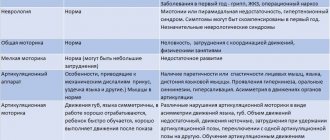Agraphia is the limitation or loss of the ability to write. It appears with speech dysfunctions. This violation can be expressed in the following manifestations:
- loss of writing skills;
- the presence of a large number of gross errors;
- impaired merging and writing of letters, words, syllables.
It arises due to damage to the posterior parts of the frontal gyrus of the brain. In childhood, writing impairment manifests itself as a consequence of alalia, which occurs when the speech center in the child’s brain is damaged. In adults, agraphia is a consequence and complication of aphasia.
Causes of agraphia
The main causes of its appearance are damage to the cortical part of the brain. This can happen for several reasons:
- brain injury of varying severity;
- tumors in the brain;
- infections;
- inflammatory processes;
- circulatory disorders;
- poisoning with certain substances.
Speech disorders (aphasia, alalia, dyslalia) are accompanied by impaired ability to write. In childhood, this can be caused by trauma during childbirth, or the peculiarities of pregnancy and childbirth. If a child has alalia, the child may experience serious problems with the ability to write. The process of writing is a complex process of neurodynamics and psyche, since it is directly related to them and interconnected with other processes taking place in brain activity.
Pathophysiology
The sensory organ specialized in taste consists of approximately 10,000 taste buds. These taste buds are ovoid bodies ranging in size from 50 to 70 micrometers. Taste buds appear in various anatomical locations, such as the mucosa of the epiglottis, palate, pharynx, and tongue papillae. In the apical part of each taste bud there are receptors that enter the oral cavity. Within each taste bud lie four morphologically distinct cell types (basal cells, type I dark cells, type I light cells, and type III intermediate cells. Basal cells are probably immature taste cells that do not spread processes into the taste pores. The last three types cells are sensory neurons and are responsible for responding to taste stimuli or flavoring substances.
The pathophysiology of ageusia depends on the factor that caused it. A person undergoing chemotherapy and radiation therapy may experience anatomical changes in taste receptor cells and sometimes death of taste receptor cells due to the higher cell turnover rate. Additionally, since saliva is important for delivering stimulants to taste cells, damage to the major salivary glands during cancer treatment may result in loss of taste. The presence of infection or inflammation in nearby areas can cause apoptosis, which can lead to a decrease in the number of taste receptor cells. They may also interfere with the ability of chemosensitive hair to detect taste stimulants.
Injury to the chorda tympani nerve during ear surgery, laryngoscopy, or any dental surgery can result in altered taste perception. The presence of any infection or injury can also damage this nerve that carries the sensory taste fibers of the tongue. Any damage to the lingual branch of the ninth cranial nerve during tonsillectomy may also result in loss of taste. Taste bud cells are altered in certain systemic diseases, which may secondary to loss of taste due to neuropathy or changes in the oral environment. Disorders include autoimmune diseases (Sjögren's syndrome), hypertension, diabetes mellitus, kidney failure, liver disease, and hyperthyroidism.
The normal aging process can also cause the sense of taste to decline, but complete loss of taste is rare. Decreased sense of taste in older patients is common due to age-related regression of taste cells, decreased saliva production, and a person's inability to chew food is completely correlated with tooth loss. In addition, geriatric patients suffer from ageusia due to polypharmacy, malnutrition, and as a secondary complication of certain oral and systemic diseases.
The taste nucleus is a paired nucleus located in the medulla; they are also called the nucleus of the solitary tract. They receive impulses from the taste buds present on the tongue through the VII, IX and X cranial nerves. After receiving these impulses, the nuclei send abundant projections to various brain regions such as the amygdala, pons, lateral hypothalamus, ventral posterior thalamic nucleus, and primary and secondary gustatory cortical areas.
Types of agraphia
There are the following types of agraphia:
- Pure or amnestic agraphia. Failures occur when writing from the dictation of another person or writing from an audio medium. When cheating, writing ability is not impaired. This type is usually accompanied by Gerstmann's syndrome, becoming its distinct symptom. In severe form, this type manifests itself in the mirror writing of words. In this case, a mirror type of pure agraphia develops.
- Apraxic form of aphasia. It manifests itself as an independent disease or may be a consequence of ideation apraxia. The child cannot understand how to hold a pen or pencil with his fingers. Moving your hand when writing does not spell the letter correctly. This form is typical for any type of writing.
- Aphasic form. This type is formed during aphasia, which is a consequence of damage to the left region of the temporal part of the brain. Also, with such a lesion, problems with auditory, speech memory, and phonetic hearing are observed.
Dyscrophia is a persistent impairment of the ability to write associated with dysfunction of the central nervous system. There are different types of this disorder.
Sensory
Sensory agraphia consists of impaired writing dictated by another person. If a person writes himself or copies from another source, the letter has the correct literacy and structure. The cause is impaired phonetic hearing and is usually accompanied by poor understanding of speech and insufficient recognition of sounds.
Afferent motor agraphia
This form is a consequence of pathologies in the lower part of the postcentral gyrus of the brain. With it, all types of writing suffer, but not copying from another source. The patient misses letters in a word, usually in the middle. One letter or an entire syllable may be missing. The patient can change the letters and write completely different ones.
Efferent motor form
The patient cannot write a word or makes substitutions of letters or syllables in it. The clinical picture of efferent agraphia is impaired writing or its complete loss. These forms of agraphia are amenable to treatment to varying degrees, the effectiveness of which depends on the severity of the time at which correctional work began.
Story
In 1553, Thomas Wilson's book The Art of Rhetoric contained the earliest known description of what would now be called acquired agraphia
In the second half of the nineteenth century, loss of the ability to produce written language came to clinical attention when ideas about brain localization influenced research on the dissociation of written and spoken language and reading and writing. Paul Brock's work on aphasia at this time inspired researchers throughout Europe and North America to begin studies of the correlation between lesions and loss of function in various cortical areas.
In the 1850s, doctors such as Armand Trousseau and John Hughlings Jackson held the prevailing view that the same linguistic deficit occurred in writing as well as in speech and reading disorders. In 1856, Louis-Victor Marsay argued that written and spoken language were independent of each other; he found that many patients with language disorders had impairments in both speech and writing. The restoration of written and oral speech did not always occur in parallel, which indicates the independence of these two modes of expression. He believed that the ability to write involves not only motor control, but also the memorization of signs and their meanings.
In 1867, William Ogle, who coined the term agraphia
, made several key observations about the patterns of dissociation found in written and spoken language. He demonstrated that some patients with writing disorders could copy written letters but had difficulty assembling the letters into words. Ogle knew that aphasia and agraphia often occur together, but he confirmed that impairment of the two different types of language (oral and written) can vary in type and severity. Although Ogle's review helped make significant advances in the understanding of writing disorders, there was no documented case of pure agraphia.
In 1884, more than two decades after research into acquired language disorders began, Albert Peatres made an important contribution by publishing a clinical report on pure agraphia. According to Pitre, Marse and Ogle were the first to emphasize the dissociation between speech and writing. His work was also heavily influenced by Théodule-Armand Ribot's modular approach to memory. A clinical study by Pitres in 1884 proves that writing resides in the brain.
Pitres' models of reading and writing consisted of three main components: visual (memory for letters and how letters fit together to form syllables and words), auditory (memory for the sounds of each letter), and motor (motor-graphic memory for writing). He proposed the following classifications of agraphia:
- Word blindness agraphia
: inability to copy a pattern, but the person can write spontaneously and in response to dictation. - Agraphia by word deafness
: inability to write from dictation, but the person can copy a model and write spontaneously. - Motor agraphia
: no ability to write, but the person can spell.
Pitres said that in aphasia, intelligence is not systematically impaired.
Twentieth-century research has focused primarily on aphasiology in patients with lesions resulting from cerebrovascular disorders. Through these studies, researchers have gained significant insight into the complex cognitive process of writing.
Symptoms
The most striking symptom of agraphia is the complete loss of writing, the destroyed structure of writing words and text, omissions of words, syllables, and letters. The child may have difficulty connecting parts of words from syllables. However, with this type of disease there is no damage to intellectual abilities; mental abilities are not affected.
Agraphia in children is a consequence of a speech disorder - alalia. Agraphia is usually detected in children with certain speech disorders.
Forms of aphasia
In the first days after a cerebrovascular accident, speech disorders in patients can manifest themselves in the form of total aphasia: the patient does not speak and does not understand speech addressed to him. Total aphasia after a few days or weeks can be replaced by sensory or motor aphasia: the patient begins to understand speech addressed to him, but communicates with others using a speech “embolus” - a stereotypically repeated sound combination, syllable or word, sometimes well intoned.
There are several forms of aphasia, but two main forms of aphasia can be distinguished:
- sensory
- motor
Diagnosis of the disease
With agraphia there are rarely problems with accurate diagnosis. The doctor must conduct a neurological examination of the patient and then render his verdict. It is necessary to establish the exact cause of the formation, to understand what triggered it.
This requires a conversation with the patient, or his parents, if we talk about a child. MRI of the head, radiography, rheovasography, EEG and other research methods may be required. To prevent agraphia, it is necessary to engage in special speech classes with the child. They should be carried out frequently and correctly.
Epidemiology
Data on the incidence of acquired neurological speech disorders, including agraphia, are generally limited. Stroke is considered the most common cause of acquired language impairment. One study from Switzerland found that the annual incidence of speech impairment due to first-ever ischemic stroke was 47 per 100,000 inhabitants; of these, 30% of stroke patients developed aphasia. This study included patients with agraphia, although the frequency of agraphia was not reported.
Treatment
Correction of agraphia in children is a long and difficult process for both parties (patient and doctor). You need to understand that treatment does not guarantee complete relief from the disorder, but it can help and move along in development with your peers. The child must be registered with a neurologist and visit him regularly. The frequency is determined by the doctor who is caring for the patient. He also determines an individual course of treatment. Correction classes can be group or individual. This condition is also determined by a speech therapist or neurologist.
Before starting correctional work on the ability to write, the specialist must pay attention to speech. In many cases, special gymnastics and physical activity are prescribed. Such classes help consolidate skills and increase the effectiveness of correctional work. The patient may be prescribed singing songs, reciting poetry, or expressive reading aloud.
Control
Agraphia cannot be treated directly, but people can be rehabilitated to regain some of their former writing abilities.
To manage phonological agraphia, people are taught to remember cue words, such as a familiar name or object, which can then help them form a grapheme for that phoneme. Managing allographic agraphy can be as simple as having alphabet cards so a person can write legibly by copying the letters in the correct shape. There are several methods for rehabilitation of apraxic agraphia; if a person has significantly better hand and movement control when typing than when writing, then they can use technological devices. Texting and typing do not require the same technical movements as handwriting; these technological techniques only require the spatial arrangement of the fingers for typing. If copying skills are maintained in a person with apraxic agraphia, repeated copying may help move from the highly intentional and controlled hand movements indicative of apraxic agraphia to more automated control.
Micrographia is a condition that can occur when other diseases such as Parkinson's disease develop and when handwriting becomes illegible due to small writing. For some people, the simple command to write more solves the problem.
Anagram and copy processing (ACT) uses the arrangement of the constituent letters of target words and then copying the target word again. It looks like a CART; the main difference is that the target words for the ACT are specific to each individual. Target words that are important in a person's life are underlined because people with profound or global agraphia typically do not have the same memory for words as other people with agraphia. Writing may be even more important for these people as it can indicate spoken language
ACT helps with this by making it easier to relearn a set of written words of personal importance for use in communication.
The Copy and Recall Technique (CART) helps restore the ability to pronounce specific words acquired by repeatedly copying and replaying target words. CART is more likely to succeed in treating lexical agraphia when a few words are taught than when a large group of unrelated words is taught
The words chosen can be personalized to the patient, making treatment more personal.
The grapheme buffer uses learning specific words to improve spelling. Cue hierarchies and the method of copying and recalling specific words are used to process words in the short-term memory loop or graphemic buffer. Segmenting longer words into shorter syllables helps store words in short-term memory.
The problem-solving approach is used as a method for self-correction of phonological errors. A person says a word and tries to spell it, usually using a device like an electronic dictionary that indicates the correct spelling. This method uses stored correspondences between letters when they are intact. This approach may improve access to orthographic memory, strengthen orthographic representations, or both.
Prevention
Prevention of the appearance and development of agraphia is:
- physical activity, especially fine motor skills of the hands and fingers;
- drawing;
- training in writing letters and words;
- general gymnastics.
It is necessary to carry out such exercises constantly, as often as possible. The result of corrective work depends on the severity of the lesion and other physiological characteristics of the patient. It is worth knowing that it is impossible to get rid of agraphia on your own at home. It is necessary to seek professional help from a speech therapist, psychologist, or neurologist. A positive result is possible with complex correction and therapy. The patient must also have support from his family and friends.
Dysorphography
Dysorthography is a persistent impairment of the writer’s ability to apply spelling rules when writing assignments or his speech intention. After all, written speech is a special form of speech that is very complexly organized. Written speech depends on the level of development of oral speech, but having such a basis, when carrying out the writing process, additional systems of the human brain are involved: motor analyzer, kinesthetic sensations, visual-motor coordination, spatial zones of the occipital zone of the brain for recalling the image of a letter, and logical zones frontal areas of the brain, and phonemic perception (temporal areas of Broca and Wernicke) and inter-analyzer connections, and the lexical and grammatical arsenal of a person. The process of writing in school education has another essential basis: the desire to write, the desire to master literacy. The persistent reluctance of a primary school student, insufficient attention, memory, underdevelopment of the volitional component of the personality, leads to a failure in the formation of timely literate writing skills. It is clear that if a child has organic damage to the cortical areas of the brain involved in the writing process, then he will have a written speech disorder: dysgraphia or dysorthography. Delayed maturation of these cortical zones, or disruption of their functioning, also leads to this condition
If a child in the early stages of his development suffered for a long time from colds or infectious diseases with an increase in temperature, then brain cells may suffer from this, and later dysgraphia and dysorphography may occur. Incorrect speech of others, bilingualism, insufficient attention to the development of the child’s speech in the family, and insufficient speech contacts lead to the emergence of such diagnoses. There is also a hereditary predisposition to dysgraphia, when the qualitative immaturity of individual brain structures involved in the organization of written speech is transmitted. Insufficient psychological readiness of a first-grader for school education leads to dysorthography
This is manifested in the characteristics of their personal and intellectual development. Spoiled, permissive, lack of desire to have something and work, overfed in all respects, leads to a lack of motivation to master something new. An inadequate attitude towards their abilities, inflated self-esteem, and towards the results of the work performed (lack of criticism, unreasonable praise) is the basis for the fact that such children have difficulty developing ways of productive educational and practical activities. Hence the imbalance and careless attitude towards learning. “The student’s level of self-awareness is decreasing and a sharp decrease in the tone of cognitive activity in general has been revealed. Especially in the field of linguistic phenomena.” Insufficient motivation for educational and practical activities is the leading factor characteristic of children with dysorthography. This translates into increased distractibility! Children with dysorthography do not clearly understand educational terminology; they cannot remember and mix up terms such as “sound,” “syllable,” and “word.” Finding the place in a word where a rule needs to be applied is a very difficult, sometimes impossible task! The spelling of zhi, shi, cha, shcha, chu, shchu, a soft separating sign belongs to such “mistaken places” and even in the 6th grade, students with dysorthography make mistakes in such words, that is, they do not learn the rules of Russian language graphics. Students do not know how to check their own mistakes because their self-control is significantly impaired, which does not allow them to find and correct a huge number of spelling errors and complicates the choice of how to check words. There is a method for correcting dysorthography that can influence the quality of students’ writing; it is based on the development of visual character recognition; analysis and synthesis (compare and contrast operations); optical-spatial recognition and design; speech-visual (oculomotor) functions, development of perception and reproduction of rhythm; visual and speech-auditory memory. The methods were created by scientists and speech therapists: Yastrebova A.V., Prishchepova I.V. based on research by Levina R.E. and expanded, specified by Ivanovskaya O.G., Gadasina L.Ya., Nikolaeva T.V. and Savchenko S.F.
And all this work will give better results if you influence the subconscious motivation of educational activities, which makes it possible to implement such a method as suggestive suggestion
Features of agraphia types
Amnestic agraphia is often accompanied by a number of neurological disorders caused by lesions of the cerebral cortex. One of them is Gerstmann's syndrome. The apraxic variety arises as a result of the ideational type of apraxia. In this case, the patient does not understand how the hand should be positioned when writing, he does not understand how to correctly move the hand and fingers.
Also, such a child is not able to understand the sequence of movements, which explains the incorrect arrangement of letters; sometimes this phenomenon can have a mirror spelling of words. In severe cases, the structure of words may completely disintegrate; the child depicts only individual fragments. Apraxic agraphia is observed in all types of writing - dictation, independent writing, copying. In this case, the order of movements, organization, and structuring of the writing of a word or phrase are disrupted.
This type is a consequence of lesions of the angular and supramarginal gyri located in the left hemisphere. In the case of aphasia, aphasic agraphia develops. When it occurs, damage occurs in the temporal part of the cerebral cortex in the left hemisphere. There is loss or deterioration in phonetic hearing and auditory-verbal memory. Constructive aphasia is characteristic of constructive aphasia.
Dyslexia
Dyslexia is a reading disorder that occurs as a result of underdevelopment or dysfunction of certain areas of the cerebral cortex. In parallel with dyslexia, a child may develop dysgraphia. Dysgraphia is a writing disorder. Dyslexia is rare, but despite this, it can make it difficult for a child to learn. Reading is at the core of the world's education system, so learning problems can have long-lasting consequences. This disease occurs mainly in boys.
Dyslexia in children in most cases appears at the age of 7 years, so problems with reading are most often observed in younger schoolchildren. Various reading disabilities become more obvious by second grade. In some cases, dyslexia is compensated over time, but sometimes it persists in older children. But with early detection and timely, comprehensive treatment, the course of dyslexia can be changed for the better. Treatment should be long-term, intensive and systematic. Sometimes a child may be genetically predisposed to this disease, in which case dyslexia is observed in several family members at once. Children with this disorder make many mistakes when reading. They read slowly, and they may pronounce words incorrectly, skip some sounds, add unnecessary ones, and rearrange letters. Children find it difficult to perceive certain sounds by ear, which leads to the fact that they do not use them in their own oral and written speech, when reading. It is very difficult for a child with dyslexia to distinguish sounds that are similar in acoustic characteristics: B-P, D-T, K-G, S-Z, Zh-Sh. That is why children with such problems have no interest in reading, retelling, or presenting various types of texts. Whenever possible, these forms of work are not given to them.
Let's look at the mechanism of development of dyslexia, this will help to better understand the essence of this disease. A person has three types of hearing: physical (the rustling of leaves, the barking of a dog, the sound of rain), musical (the pleasure of a favorite song, the immortal music of great composers), speech (understanding speech, the difference between sounds). When speech hearing is not sufficiently developed, a person is unable to distinguish similar consonances and does not correctly perceive speech addressed to him. When speech hearing is impaired, difficulties arise in reading and writing. This is a natural process, because a child who cannot clearly hear the speech of other people cannot read correctly. In a child with dyslexia, the relationship between sounds and letters is disturbed. Having heard a sound, he is not able to quickly imagine it in the form of a sign. But the flow of speech that he perceives is very fast. That is why mastering literacy is difficult for such children.
But it is necessary to teach a child, since a change in one or more sounds entails a change in the meaning of the word: stick-beam, daughter-dot. The child just replaces a dull sound with a voiced one, a hard sound with a soft one, but the word completely changes its meaning. To correct dyslexia in a child, parents must not only work with him on their own, but also be sure to involve a specialist. All classes aimed at correcting a child’s reading must be built in a certain system. During the lessons, the child must master the pronunciation of individual sounds and learn to relate the sound to the letter. For better results, the speech therapist uses various visual materials. You need to understand that dyslexia is a condition that requires the cooperation of parents and a speech therapist to identify and correct it; only in this case can lasting positive results be achieved.
Forecasts
With agraphia, it is impossible to give accurate guaranteed forecasts for the result of correction. The cause of this disease is damage to the speech centers of the brain. If this problem can be eliminated at the physical level, then agraphia is completely removable. If the damage is extensive and persistent, we can talk about compensation of some manifestations, but not about a complete recovery of the child or adult.
You need to work and study with the patient, pay a lot of attention to him. You cannot ignore the problem and let it take its course. This problem will not go away on its own, and the patient will develop poor communication skills with others. In mild cases, children can establish contact with their peers, but in severe cases this is difficult to do.
Dysgraphia (handwriting and written speech disorders)
Dysgraphia is a partial disorder of the writing process associated with insufficient formation (or decay) of higher mental functions involved in the implementation and control of written speech.
Dysgraphia is manifested by persistent, typical and repeated errors in writing, which do not disappear on their own, without targeted training and correction.
Corrective work to overcome dysgraphia requires the elimination of violations of motor skills, coordination, balance, attention, concentration, perception, as well as sound pronunciation, the development of phonemic processes, vocabulary, grammar, and coherent speech.
Mastering written language (reading and writing) requires balanced functioning of the whole brain. It is not surprising that dysgraphia (impaired learning of written language), dyslexia (impaired reading) and dysorthography are the main problems of schoolchildren around the world. The brains of many children cannot cope with processing information coming from the senses - vision, hearing, tactility, etc.
Advice to read more and write more usually does not bring results. Problems with reading and writing always have specific neurological causes; these dysfunctions force the brain to work in constant overload mode, which is why the child is often tired or, on the contrary, overactive.
An experienced teacher may notice that the student is clumsy, “turns a deaf ear” (as if he doesn’t hear), is restless, “counts crows,” is often distracted, and constantly fails to keep up.
However, the severity of these problems and their causes can be much more effectively identified by a neuropsychologist during neuropsychological diagnostics using special test tests and unique innovative devices.
Dysgraphia is a specific deficiency in writing caused by a violation of the HMF (higher mental functions) involved in the process of written speech.
The high prevalence of dysgraphia among schoolchildren is associated with the fact that about half of graduates of kindergartens and preschoolers enter the first grade with FPD or OPD, in the presence of which the process of full mastery of literacy is impossible.
This is a disorder that cannot be “outgrown”, it will not “resolve” on its own even in adulthood, it greatly spoils and complicates life, creates many psychological problems and complexes.
This is a disorder that can be “stopped” only with the help of neuropsychological correction quite quickly and effectively – once and for all; other methods only “clean up” the symptoms, temporarily easing their manifestation, but do not solve the problem as a whole!!!
Since writing and reading are inextricably linked, writing disorders (dysgraphia, agraphia) are usually accompanied by reading disorders (dyslexia, alexia).
Mastery of the writing process is closely related to the degree of formation of all aspects of oral speech:
- sound pronunciations,
– phonemic perception,
– lexical and grammatical aspects of speech,
- coherent speech.
The appearance of dysgraphia can be caused by underdevelopment or damage to the brain in the perinatal, natal, postnatal periods; dysgraphia can be caused by:
– pathology of pregnancy,
– birth injuries,
- asphyxia,
– meningitis
– encephalitis,
– infections and severe somatic diseases that cause depletion of the child’s nervous system.
Signs of agraphia in children
In recent years, the number of children with this disorder has increased. Parents should know the first signs of this disease in order to begin compensation and correction in time. The main reason is the child’s speech, reading, and writing impairments. To confirm the diagnosis, an encephalogram and additional speech therapy and neurological studies must be performed. Only after this can we talk about the presence or absence of agraphia.








